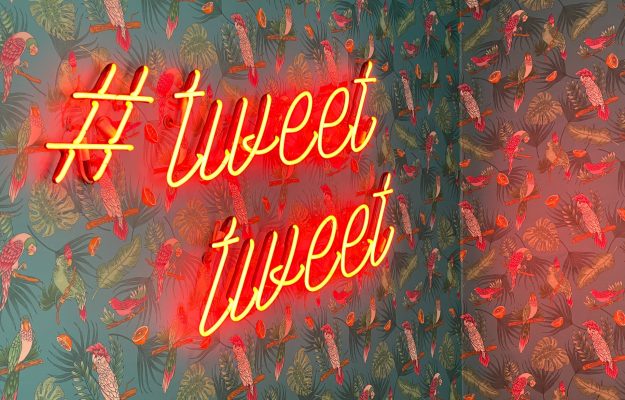
When an article publishes on your website, how do you go about promoting it in social media? When we pose this question to a room full of magazine editors from different publications, their answer is typically that they wait for the post to be published and then they promote it. If they’re super savvy, they might also schedule a Tweet (using Hootsuite or CoSchedule) a week later. Valiant effort, for sure, but simply not enough, and it’s usually a lack of Tweet ideas, amongst other things.
[text_ad]
Back in 2012, we had been digging deep into our blockbuster report. This is a list of the top articles sending traffic to our site. For many of our publishing partners, these blockbuster posts, which are SEO-optimized, account for more than half of their website traffic.
While digging into our blockbusters, we were taking note of the ones that were beginning to slip. For us, a slipped blockbuster can mean losing hundreds to tens of thousands of search visitors per month.
Amanda MacArthur, our Daily editor decided that one of the ways we might recover this position was to re-promote it through our social media channels and treat it as if the content was brand new again. In many cases, we began to recover those positions. From there we decided that any one post needs to be promoted more strategically than most of us were doing at the time – and from there, her Tweet formulas were born and have been trialed and tested ever since.
Let’s dig into this step by step. Grab a pen or a spreadsheet.
To start, pick the most recent article you’ve published on your blog. Hopefully it’s SEO’d for search and contains evergreen content (content that doesn’t expire with the direction of the wind) because this content performs best using this strategy.
The 12x12x12 Twitter Strategy
Next, begin to think up different ways you can promote your article. Keep in mind, that this is by no means an exhaustive list of every Twitter formula that could exist and in fact I suggest that you test these out and create your own. The purpose of using these formulas is to determine which ones your audience responds to best, and then improve from there.
12 Tweet ideas:
- The subtitle: Easy, just use the subtitle
- The subtitle + context: The subhead, plus a little more to make it catchy
- The excerpt: Interesting statement
- The summary: What they’ll learn by clicking the link
- The shout-out: @ anybody mentioned
- The hashtag(s): Insert extra (related) trending hashtags
- The quote: Find a relevant quote and use it
- The quippy click-bait: Short and sweet
- The friendly suggestion: First-person request to read/share
- The question: Ask a related question
- The engagement: Ask them to comment/give feedback
- The takeaway(s): Subheads and major points
We’ll run through 12 examples of these Tweet ideas below, and then how these posts would be scheduled for maximum effectiveness.
Below we’ve created examples using a general-interest magazine publisher, Good Housekeeping. The post is titled, How to Fix a Sedentary Lifestyle (Because It’s Never Too Late to Get Moving).
1. The subtitle: Easy, just use the subtitle
Goal: Your title show up in the preview automatically, so find out if your subtitle is click-worthy enough and test which subtitles in your Tweets end up performing best. It’s a great way to test subtitle formulas for your articles.
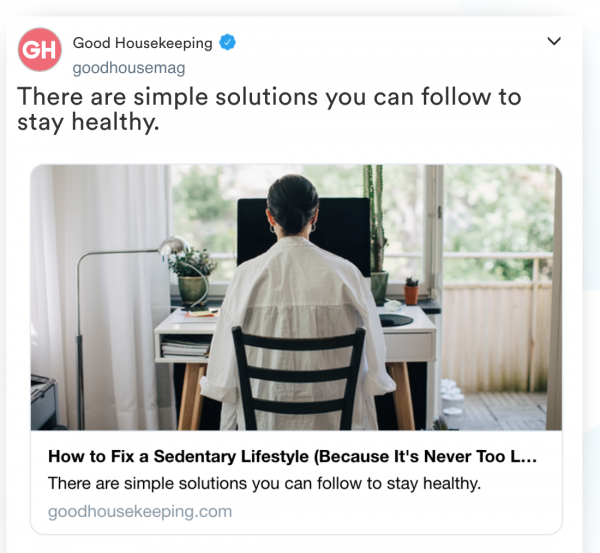
2. The subtitle + context: The subhead, plus a little more to make it catchy
Goal: Add more context to the Tweet, which often leads to retweets if it’s catchy.
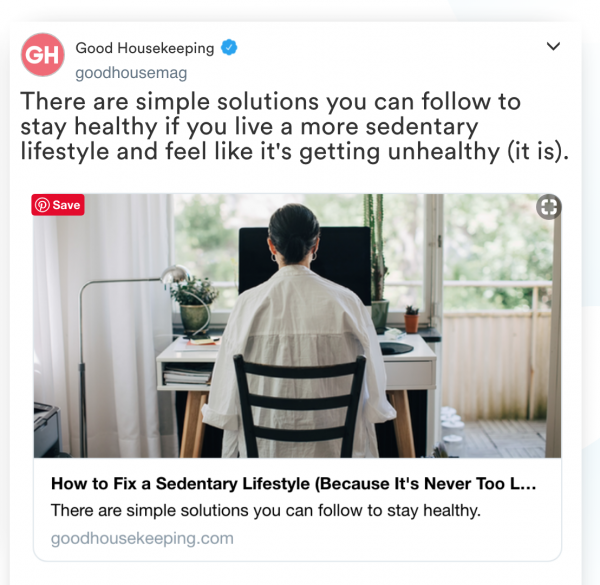
3. The excerpt: Interesting statement
Goal: Make a bold statement from the article to get more retweets.
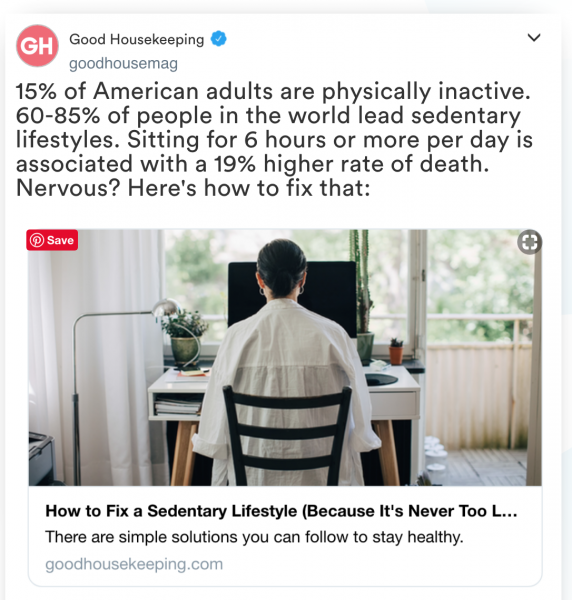
4. The summary: What they’ll learn by clicking the link
Goal: Give them the facts, and challenge them to keep reading to find out why your statement is so.
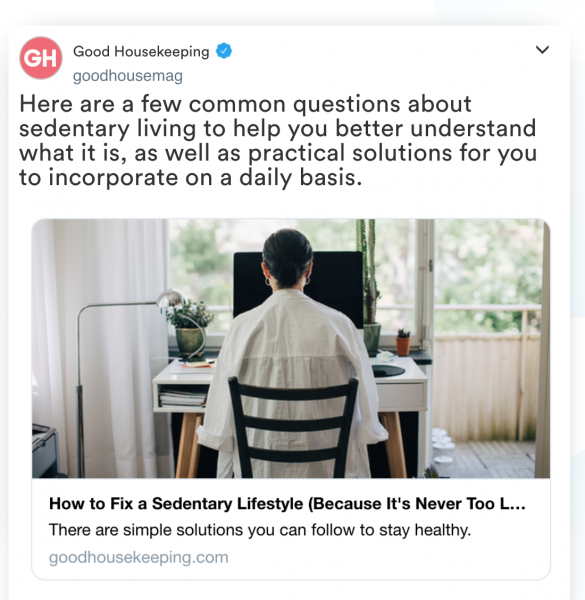
5. The shout-out: @ anybody mentioned
Goal: Get your post in front of the people you’ve mentioned and hope for them to retweet the post too.
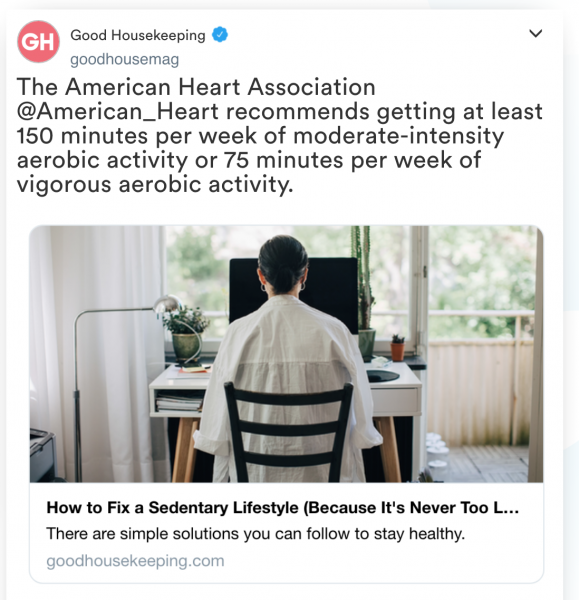
Download a FREE copy of Best Email Subject Lines for Selling Premium Subscriptions and Memberships and discover an extensive list of email subject line frameworks that are consistently proven to sell and boost revenue for publishers.
6. The hashtag(s): Insert extra (related) trending hashtags
Goal: Get your post in front of other like-minded readers who enjoy similar topics.
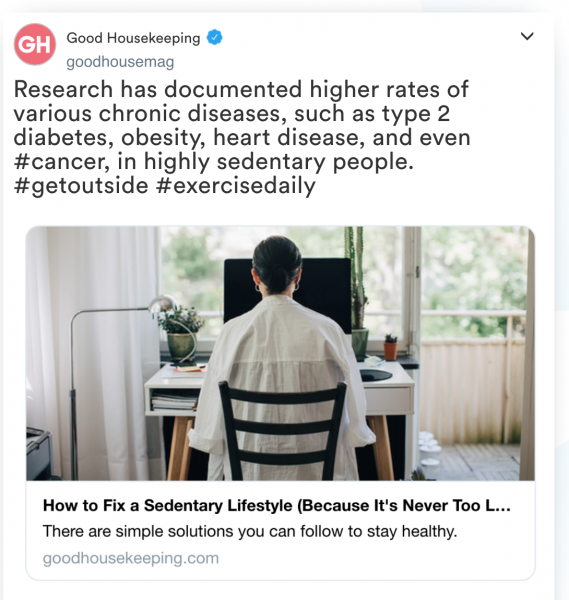
7. The quote: Find a relevant quote and use it
Goal: People love to retweet quotes, and retweets send great social signals to Google about your post.
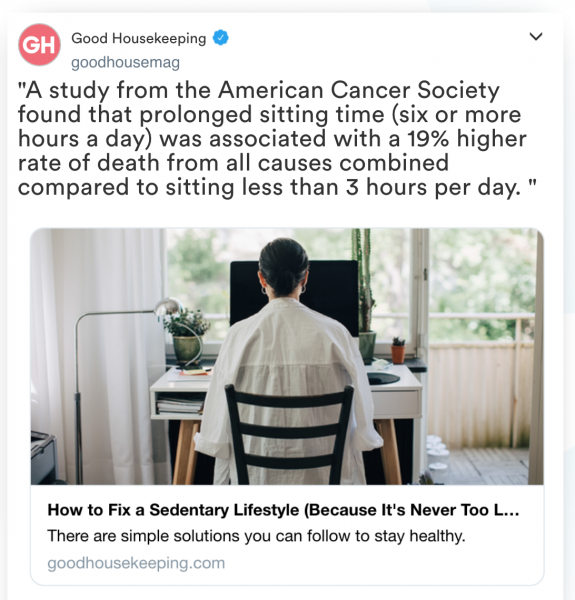
8. The quippy click-bait: Short and sweet
Goal: Forget the small talk, just get them to click and read like the example below. Write something that challenges them to click. For example, if you have a list post, say something like “you’ll never believe what #4 is!”.
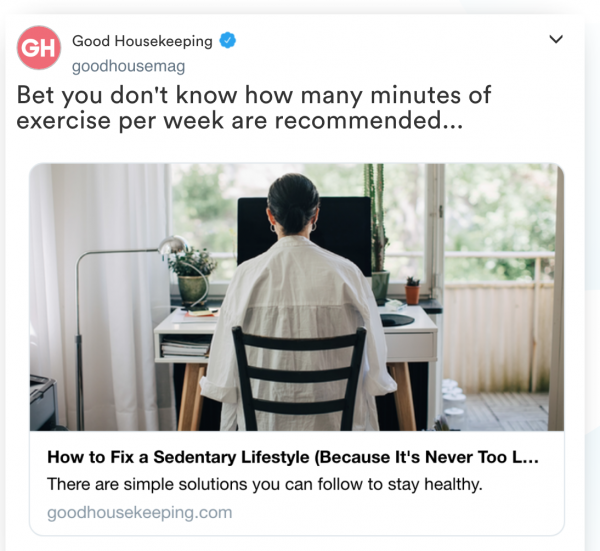
9. The friendly suggestion: First-person request to read/share
Goal: This first-person request can garner more replies, retweets and favorites based on the personal nature of the request.
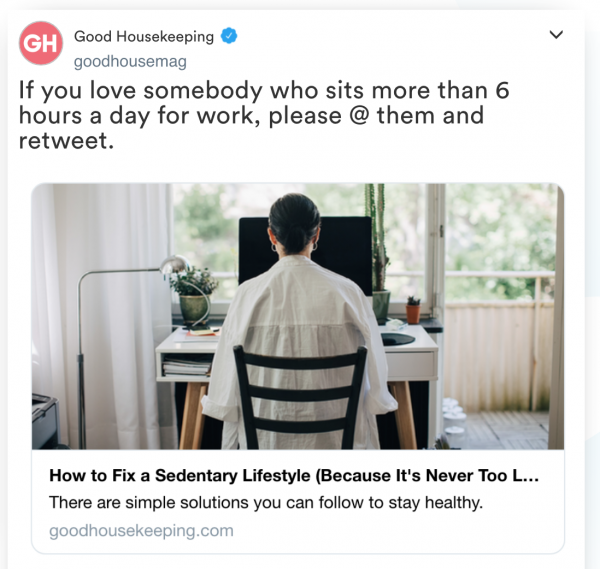
10. The question: Ask a related question
Goal: Inspire followers to engage with you. Ask them a question related to the article and get them to read on.
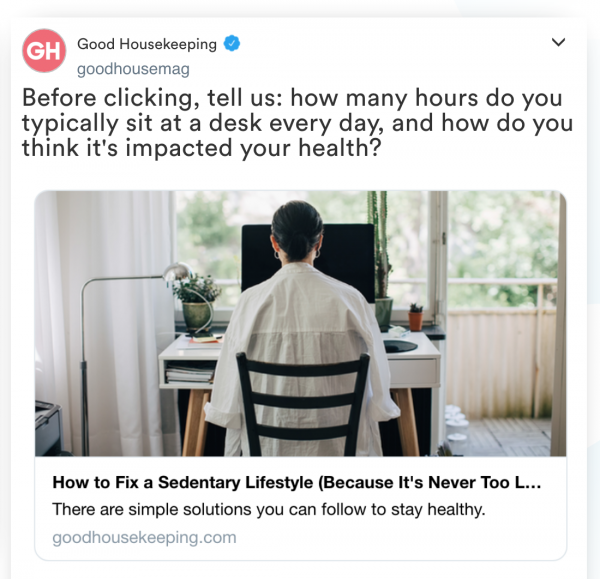
11. The engagement: Ask them to comment/give feedback
Goal: Get followers to your site and boost its SEO with more post comments.
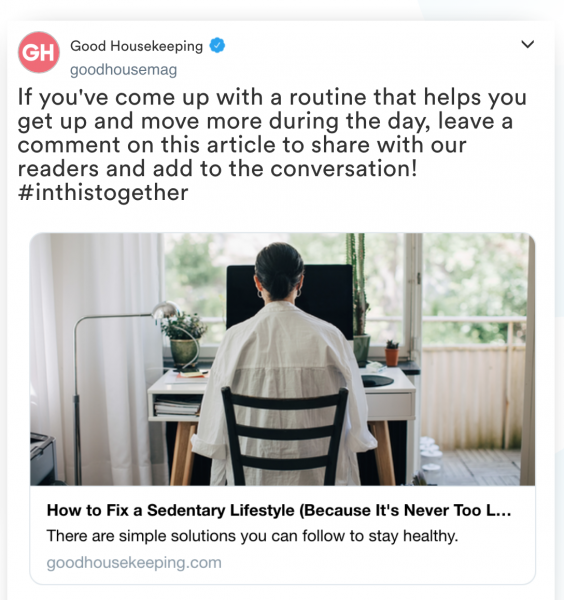
12. The takeaway(s): Subheads and major points
Goal: Lay it all out there. Some people just want the facts, Jack. Bring on the retweets.
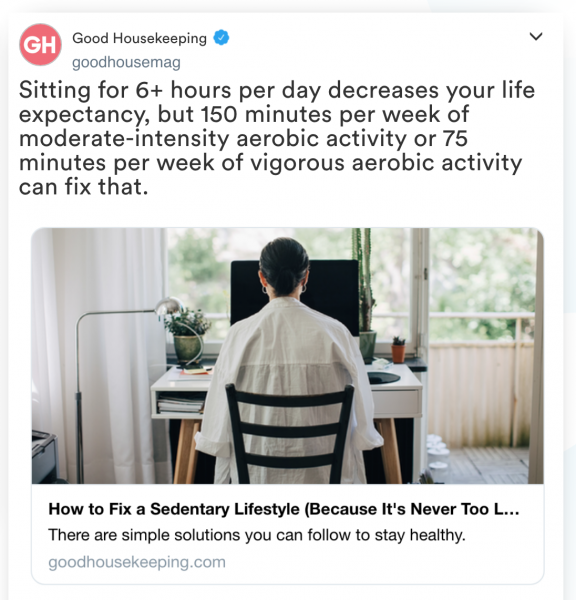
Scheduling Your New Tweet Ideas
Now that you’ve written your Tweets, you’ll want to schedule them. Here’s a basic twelve-day schedule for a publisher that posts one article per day.
Daily Publishing Schedule
- Title: January 1st, 9am (the first time the article is promoted)
- Title & Subhead: January 2nd
- Excerpt: January 3rd
- Summary: January 4th
- Shout-Out: January 5th
- Hashtag: January 6th
- Quote: January 7th
- Quippy Click: January 8th
- Friendly Suggestion: January 9th
- Question: January 10th
- Engagement: January 11th
- Takeaway: January 12th
Monthly Publishing Schedule
- Title: February 1st
- Title & Subhead: March 1st
- Excerpt: April 1st
- Summary: May 1st
- Shout-Out: June 1st
- Hashtag: July 1st
- Quote: August 1st
- Quippy Click: September 1st
- Friendly Suggestion: October 1st
- Question: November 1st
- Engagement: December 1st
- Takeaway: January 1st
Promotional Tweets
And don’t forget promotional Tweets. If you follow the Mequoda best practice of sending several spotlights (promotional) emails per week, and one circ-builder (freebie) per week – set up promotional Tweets for the same days. Feel free to use the formulas above, or make up your own!
You can also try:
- Using the headline from your promotional email
- Excerpting from your landing page
- @ing out the cover story company / model of your product
- Giving away one solid take-away (a mini recipe, a quote, an image, something only paid buyers will get)
- Showing a photo of you holding / reading / using the product
- Using the 12x12x12 formula as if it was an article.
Can You Use These Tweet Ideas on Other Social Networks?
Why, yes! On Twitter, no one user is going to see every Tweet you send out, because the timeline moves so quickly in real-time and scheduling 12 at a time is no biggie. But these Tweet ideas can extend beyond Twitter. Less content is shared on platforms like Facebook and LinkedIn and Pinterest, so we recommend using the same formulas above, except only once and then again six months later. Replace @ing for tagging in the shout-out. Everything else works the same except descriptions can be longer if you need them to be.
In particular, the following formulas from above work great on Facebook:
- The excerpt: Find the most interesting thing in the article and excerpt it.
- The shout-out: Tag anyone mentioned in the article, which can help it get shared by those companies, celebrities, etc.
- The quote: Find a relevant quote from the article that people might agree or better, disagree with, to start a dialogue.
- The quippy click-bait: Write something that challenges them to click. For example, if you have a list post, say something like “you’ll never believe what #4 is!”.
- The question: Ask a related question to get people to comment. In some cases you can ask people to reply with a GIF. Comments increase the visibility of a post, which in turns increases clicks from a wider audience.
You can also try toying with images. Try switching up your featured image on posts to see which ones work best. Here are some more Facebook posting tips.
If you follow all of the advice above for every post, especially the ones optimized for search, you’ll find that they rank higher and longer. The ones that you don’t do it for, will simply dissolve into your online archives.
Which of the above tweet ideas work best for you?



These are awesome tips! Thanks you.